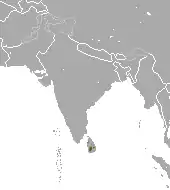| Paradoxurus zeylonensis[1] | |||
| (Schreber, 1778) | |||
 | |||
| Systematyka | |||
| Domena | |||
|---|---|---|---|
| Królestwo | |||
| Typ | |||
| Podtyp | |||
| Gromada | |||
| Podgromada | |||
| Infragromada | |||
| Rząd | |||
| Podrząd | |||
| Rodzina | |||
| Podrodzina | |||
| Rodzaj | |||
| Gatunek |
łaskun cejloński | ||
| Synonimy | |||
|
| |||
| Kategoria zagrożenia (CKGZ)[7] | |||
 | |||
| Zasięg występowania | |||
 | |||
Łaskun cejloński[8] (Paradoxurus zeylonensis) – gatunek drapieżnego ssaka z podrodziny łaskunów (Paradoxurinae) w obrębie rodziny wiwerowatych (Viverridae). Gatunek słabo poznany.
Taksonomia
Gatunek po raz pierwszy zgodnie z zasadami nazewnictwa binominalnego opisał w 1778 roku niemiecki przyrodnik Johann Christian Daniel von Schreber nadając mu nazwę Viverra zeylonensis[2]. Holotyp pochodził ze Sri Lanki[9].
Ostatnie badania genetyczne wykazały, że na Sri Lance występuje tylko jeden gatunek z obrębu rodzaju Paradoxurus[10]. Autorzy Illustrated Checklist of the Mammals of the World uznają ten gatunek za monotypowy[11].
Etymologia
Zasięg występowania
Morfologia
Długość ciała (bez ogona) 50,2–58 cm, długość ogona 43,7–52,5 cm; masa ciała 3–6 kg[14]. Niewielki łaskun o złotobrązowym ubarwieniu. Wzór zębowy: I C P M = 40[14].
Tryb życia
Gatunek nadrzewny, przebywa w koronach dużych drzew. Tryb życia i biologia rozrodu tego gatunku nie została poznana. Jest aktywny nocą. Przypuszczalnie samica rodzi 2-3 młodych w jednym miocie. Pojawianie się młodych osobników obserwowano w październiku i listopadzie. Paradoxurus zeylonensis żywi się głównie owocami. Zanotowano również przypadki zjadania małych kręgowców i owadów.
Przypisy
- ↑ Paradoxurus zeylonensis, [w:] Integrated Taxonomic Information System (ang.).
- 1 2 J.Ch.D. von Schreber: Die Säugthiere in Abbildungen nach der Natur, mit Beschreibungen. T. 3. Erlangen: Expedition des Schreber’schen säugthier- und des Esper’schen Schmetterlingswerkes, 1778, s. 451. (niem.).
- ↑ J.F. Gmelin: Systema naturae per regna tria naturae : secundum classes, ordines, genera, species, cum characteribus, differentiis, synonymis, locis. Wyd. Ed. 13., aucta, reformata. T. 1. Lipsiae: Impensis Georg. Emanuel. Beer, 1788, s. 89. (łac.).
- ↑ F. Cuvier. Du genre Paradoxure et de deux espèces nouvelles qui s’y rapportent. „Mémoires du Muséum d’histoire naturelle”. 9, s. 48, ryc. 4, 1822. (fr.).
- 1 2 E.F. Kelaart: Prodromus Faunæ Zeylonicæ; being Contributions to the Zoology of Ceylon. London: Printed for the Author, 1852, s. 40. (ang.).
- ↑ C.P. Groves, Ch. Rajapaksha & K. Manemandra-Arachchi. The taxonomy of the endemic golden palm civet of Sri Lanka. „Zoological Journal of the Linnean Society”. 155 (1), s. 250, 2009. DOI: 10.1111/j.1096-3642.2008.00451.x. (ang.).
- ↑ J.W. Duckworth i inni, Paradoxurus zeylonensis, [w:] The IUCN Red List of Threatened Species 2016, wersja 2021-3 [dostęp 2022-04-20] (ang.).
- ↑ W. Cichocki, A. Ważna, J. Cichocki, E. Rajska-Jurgiel, A. Jasiński & W. Bogdanowicz: Polskie nazewnictwo ssaków świata. Warszawa: Muzeum i Instytut Zoologii PAN, 2015, s. 140. ISBN 978-83-88147-15-9. (pol. • ang.).
- ↑ D.E. Wilson & D.M. Reeder (redaktorzy): Species Paradoxurus zeylonensis. [w:] Mammal Species of the World. A Taxonomic and Geographic Reference (Wyd. 3) [on-line]. Johns Hopkins University Press, 2005. [dostęp 2022-04-20].
- ↑ G. Veron, M.-L. Patou, M. Tóth, M. Goonatilake & A.P. Jennings. How many species of Paradoxurus civets are there? New insights from India and Sri Lanka. „Journal of Zoological Systematics and Evolutionary Research”. 53 (2), s. 161–174, 2015. DOI: 10.1111/jzs.12085. (ang.).
- 1 2 C.J. Burgin, D.E. Wilson, R.A. Mittermeier, A.B. Rylands, T.E. Lacher & W. Sechrest: Illustrated Checklist of the Mammals of the World. Cz. 2: Eulipotyphla to Carnivora. Barcelona: Lynx Edicions, 2020, s. 412. ISBN 978-84-16728-35-0. (ang.).
- ↑ T.S. Palmer. Index Generum Mammalium: a List of the Genera and Families of Mammals. „North American Fauna”. 23, s. 513, 1904. (ang.).
- ↑ zeylonensis, [w:] The Key to Scientific Names, J.A. Jobling (red.), [w:] Birds of the World, S.M. Billerman et al. (red.), Cornell Lab of Ornithology, Ithaca [dostęp 2022-04-20] (ang.).
- 1 2 A.P. Jennings & G. Veron: Family Viverridae (Civets, Genets and Oyans). W: D.E. Wilson & R.A. Mittermeier (redaktorzy): Handbook of the Mammals of the World. Cz. 1: Carnivores. Barcelona: Lynx Edicions, 2009, s. 229–230. ISBN 978-84-96553-49-1. (ang.).
Bibliografia
- Golden Palm Civet (Paradoxurus zeylonensis). Lioncrusher’s Domain. [dostęp 2007-12-30]. (ang.).
- K. Schweighoefer: Paradoxurus zeylonensis. (On-line), Animal Diversity Web, 1999. [dostęp 2007-12-30]. (ang.).
- D.E. Wilson & D.M. Reeder (redaktorzy): Species Paradoxurus zeylonensis. [w:] Mammal Species of the World. A Taxonomic and Geographic Reference (Wyd. 3) [on-line]. Johns Hopkins University Press, 2005. [dostęp 2022-04-20].